 Let’s bone up on osteoporosis, as it is a significant concern for many women in menopause. Make no bones about it … osteoporosis can result in premature death, especially in the case of hip fracture. According to Osteoporosis Canada, at least 1 in 3 women and 1 in 5 men will break a bone as a result of osteoporosis in their lifetime. Of those unfortunate enough to experience a hip fracture, 28% of women and 37% of men will die within the following year.
Let’s bone up on osteoporosis, as it is a significant concern for many women in menopause. Make no bones about it … osteoporosis can result in premature death, especially in the case of hip fracture. According to Osteoporosis Canada, at least 1 in 3 women and 1 in 5 men will break a bone as a result of osteoporosis in their lifetime. Of those unfortunate enough to experience a hip fracture, 28% of women and 37% of men will die within the following year.
When not deadly, osteoporosis can result in reduced (or lost) mobility and disfigurement, leading to decreased independence and lower self-esteem. Effectively preventing osteoporosis is paramount to our health and well-being.
What is osteoporosis?
Osteoporosis is a loss of bone mass and a weakening of bone. Throughout our lives, bone is remodeled, i.e. it is continuously broken down and rebuilt. The cells that break down bone (also called bone resorption) are called osteoclasts. Those that build bone are called osteoblasts.
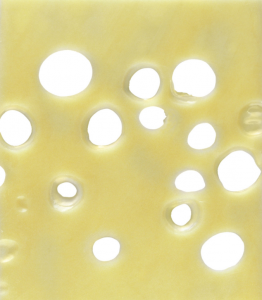 Osteoporosis occurs when osteoclast-mediated bone loss (resorption) outpaces the osteoblasts’ ability to rebuild bone to fill the empty spaces. So you can develop osteoporosis if you lose too much bone, don’t make enough bone, or some combination of both. When this happens, the bones start looking a bit like Swiss cheese. Osteoporosis literally means “porous bone”.
Osteoporosis occurs when osteoclast-mediated bone loss (resorption) outpaces the osteoblasts’ ability to rebuild bone to fill the empty spaces. So you can develop osteoporosis if you lose too much bone, don’t make enough bone, or some combination of both. When this happens, the bones start looking a bit like Swiss cheese. Osteoporosis literally means “porous bone”.
Osteopenia is defined as low bone mineral density. While often a precursor to osteoporosis, not everyone with osteopenia will go on to develop osteoporosis. Osteoporosis is often referred to as a “silent disease” as generally there are no symptoms and most people are not aware they have it until something breaks.
Why does the risk of osteoporosis rise in menopause?
Osteoporosis becomes a greater concern in menopause as women in this stage of life lose the protective effects of estrogen. Estrogen inhibits the breakdown (or resorption) of bone by slowing down the formation of osteoclasts. Bone density typically peaks around the age of 35, after which you lose approximately 1% of your bone mass per year. But as estrogen levels decline and its protective effect along with it, bone loss begins to accelerate.
This acceleration starts approximately 2 to 3 years before the last menses and ends 3 to 4 years after menopause. Eventually, losses return to an average of about 1% annually for most women but this can be higher depending on several lifestyle factors and will continue for the rest of your life. As you have a finite amount of bone to work with, it is important to slow the loss as much as possible if you want to remain hale and hearty into your nineties.
How do I prevent osteoporosis?
The best approach to avoid a disabling fracture as we age is to:
- avoid falling and
- keep your bones as strong and healthy as possible so that they are less likely to fracture if you do fall!
Avoid falling
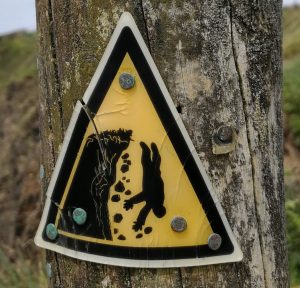 I just returned from hiking in the UK and I couldn’t resist using my photo of a sign posted on the Llwybr Arfordir Cymru (more easily pronounced and better known as the Wales Coast Path). There are some crazy sections of the path that are literally steps away from sheer cliff drops, so this sign is not an exaggeration (and I was very glad that it was not wet, slippery or windy)!
I just returned from hiking in the UK and I couldn’t resist using my photo of a sign posted on the Llwybr Arfordir Cymru (more easily pronounced and better known as the Wales Coast Path). There are some crazy sections of the path that are literally steps away from sheer cliff drops, so this sign is not an exaggeration (and I was very glad that it was not wet, slippery or windy)!
To reduce your risk of a fall:
- improve your balance and muscle strength (see next sections)
- wear sensible shoes (no high heels or slide-in type sandals and be sure all shoes have a solid, grippy tread)
- reduce tripping hazards (channel your inner Marie Kondo and eliminate clutter)
- avoid medications which may cause dizziness (e.g. sleep medications, Valium and Xanax are particularly bad for this)
Improve your balance
If you have good balance, you are less likely to fall. Full stop. As you know I am a huge fan of yoga and yoga does wonders for balance. As this article from Yoga Journal mentions, we often think of static poses like Tree Pose when thinking of balance. But falls do not usually occur when we are in steady state. They are more likely to happen when we are moving from one position to another. So mastering our ability to maintain balance as we transition from one move to another is the key to preventing a fall. This sequence of 15 Poses Proven to Build Better Balance shows you some yoga flows that will help with this. Some moves are more advanced so, if you are new to yoga, it is best to take some classes with a qualified teacher to ensure you are performing the postures safely and correctly.
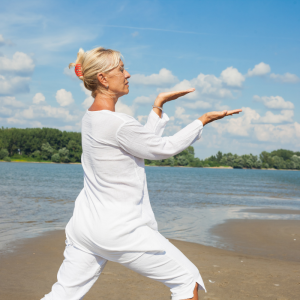 Tai chi is also excellent for balance. A study published last year found that among adults over 70 who practiced tai chi twice a week for an hour (over the 6 month study period), the incidence of falls was reduced by 58 percent. “With a lot of the classic tai chi moves, you make a fairly large step out, or to the side. Or you lean forward, with your trunk. You’re putting yourself in a position of almost falling” says study author Dr. Eckstrom. This trains the body to remain stable when put in an off-kilter position. This video excerpt from BodyWisdom’s Tai Chi for Beginners with Chris Pei is a good introduction.
Tai chi is also excellent for balance. A study published last year found that among adults over 70 who practiced tai chi twice a week for an hour (over the 6 month study period), the incidence of falls was reduced by 58 percent. “With a lot of the classic tai chi moves, you make a fairly large step out, or to the side. Or you lean forward, with your trunk. You’re putting yourself in a position of almost falling” says study author Dr. Eckstrom. This trains the body to remain stable when put in an off-kilter position. This video excerpt from BodyWisdom’s Tai Chi for Beginners with Chris Pei is a good introduction.
Also excellent for core strength and stability is Pilates. This is why I prefaced this post with an entire blog post devoted to the practice. Click here to read my interview with Pilates guru Stephanie Slater. And don’t forget dancing. If you didn’t see it in May’s Dishing it Up post, dancing appears to be the “kale of exercise“.
Strength training is the single most effective exercise to prevent osteoporosis
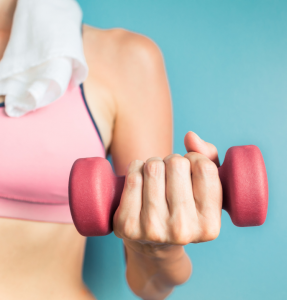 All exercise will, to a degree, reduce your risk of fracture through improving coordination and/or muscle strength and/or bone strength. Improving muscle strength (especially in your legs) means you will find it easier to move from one position to another (from sitting to standing, for example) and so are less likely to topple over.
All exercise will, to a degree, reduce your risk of fracture through improving coordination and/or muscle strength and/or bone strength. Improving muscle strength (especially in your legs) means you will find it easier to move from one position to another (from sitting to standing, for example) and so are less likely to topple over.
But the mother of all muscle strengtheners and the single most effective exercise to prevent osteoporosis is strength training (aka weight training, aka resistance training). This is because strength training has the most impact of any exercise on improving bone density.
Along with a healthy diet (which I will get to shortly), the single most important thing you can do to prevent osteoporosis is to strength train. I have said this twice because I cannot stress this enough. As stress, you see, is what strength training does. It stresses the bones and, in response, the bones (as well as the muscles) adapt and become stronger.
It is never too late to start
No exercise will help you reduce bone loss more than strength training. So, if you are a woman over fifty, strength training should move to your A list of priorities pronto! It is never too late to start strength training. If you want some serious inspiration, check out Linda Leightly. She began lifting weights at 60 and, by 72, had garnered nearly a dozen world records in her age and weight categories. This woman can dead-lift 273 pounds. I want to be her.
In the video, Linda emphasizes the importance of proper form and safety to avoid injury. Before starting any weight training program, it is a good idea to invest in a few sessions with a personal trainer or join a class with a qualified instructor to make sure you are performing exercises properly. This free Strength training: How-to video collection from the Mayo Clinic is also a good resource. Healthy adults should aim to do strength training exercises that work the major muscle groups at least twice a week. And don’t forget to breathe!
Ironically, what builds bone density and prevents osteoporosis may be a risk factor for fracture once you have osteoporosis. So if you have osteoporosis and are reading this, speak to your primary care physician about an exercise routine that is safe for you. And visit Osteoporosis Canada for further information regarding exercises for healthy bones, including videos and booklets.
Don’t drink, don’t smoke – what do you do?
Subtle innuendoes follow
There must be something inside…
These are lyrics from one of my fave 80s Britpop songs (Goody Two Shoes by Adam Ant, in case it is niggling at you). But they are also a great prescription to help avoid osteoporosis. Don’t drink. Don’t smoke. (So) What do you do? There must be something inside… I know his subtle innuendoes were not about healthy eating and digestion improving bone health, but mine are!
Calcium
Calcium has many important functions in the body. It is essential for heart function, muscle contraction and is part of the buffering system to maintain the pH of the blood. If blood pH is not properly maintained within a very narrow range, the body’s enzyme systems no longer function properly. As I mentioned in a previous post, the body performs an estimated 37,000,000,000,000,000,000,000 chemical reactions every second to function. And every one of those reactions is catalyzed by an enzyme. So when enzyme systems fail, it is basically game over.
Calcium is so important for life that your body very closely controls the amount of it in your cells and blood. Part of the function of bone (besides holding you up, protecting you organs, allowing you to move and producing blood cells) is to be a repository for calcium, so the body always has stores of it to call upon as needed. If blood calcium falls too low, the body will pull it from the bones, which weakens them. This is why it is so important to get adequate calcium in your diet daily, so that the bone reserves are not required.
Dietary sources of calcium
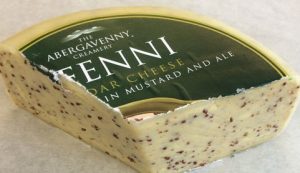 Most people generally get sufficient calcium in their diet through dairy products like milk, yogurt and cheese. [Pictured at left is my personal “Holy Grail” of cheese. I first tasted it almost two decades ago in a pub near Tintern Abbey. I never knew its name and have been searching for it ever since. So it was a bit of a crusade for me, when in Wales recently, to find it. And I did. It is Y-Fenni].
Most people generally get sufficient calcium in their diet through dairy products like milk, yogurt and cheese. [Pictured at left is my personal “Holy Grail” of cheese. I first tasted it almost two decades ago in a pub near Tintern Abbey. I never knew its name and have been searching for it ever since. So it was a bit of a crusade for me, when in Wales recently, to find it. And I did. It is Y-Fenni].
If dairy is not a part of your diet (either due to allergy, lactose intolerance or a vegan lifestyle), there are lots of other excellent calcium sources. Review this list by Healthline of the Top 15 Calcium-Rich Foods and you will see many of them are not from dairy (or animal) sources. Examples include seeds (especially sesame), beans, lentils, nuts (especially almonds), certain fruits (e.g. figs) and vegetables (such as kale, cabbage, collards and broccoli). Have a look at my Dairy-Free Bone Building Menu for some recipe ideas for those avoiding dairy due to allergy or lactose intolerance (and some, but not all, recipes here are also vegan-friendly).
Many studies show that bone health correlates better with fruit and vegetable intake than with dairy intake, leading to the hypothesis that calcium from non-dairy sources may be better absorbed by the body than that from dairy but the jury appears to still be out on that one.
Beware oxalates and phytates
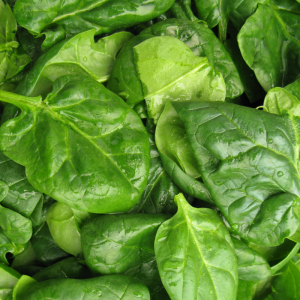 Oxalates and phytates are compounds in food that interfere with our body’s absorption of calcium from these foods. Spinach and rhubarb, while both high in calcium, are also high in oxalates, so they are not the best calcium sources. Beans tend to be high in phytates, but you can reduce the level of these by soaking them in water for several hours, rinsing them and then cooking them in fresh water.
Oxalates and phytates are compounds in food that interfere with our body’s absorption of calcium from these foods. Spinach and rhubarb, while both high in calcium, are also high in oxalates, so they are not the best calcium sources. Beans tend to be high in phytates, but you can reduce the level of these by soaking them in water for several hours, rinsing them and then cooking them in fresh water.
Aim for adequate calcium and don’t overdo it on supplements
Your body generally absorbs calcium from food better than calcium from supplements so get your calcium from food whenever possible. And if you are taking supplements, do not overdo it as more is definitely not better when it comes to calcium. Adequate calcium is the target. Currently 1200 mg is the recommended dietary allowance (RDA) set by Health Canada for women over 50 and men over 70 (do not exceed 2000 mg). The RDA for younger adult women and men is 1000 mg (do not exceed 2500 mg).
Vitamin D
Calcium, while in a starring role, is nothing without vitamin D as best supporting actor. Vitamin D is responsible for a cascade of effects that increases the absorption of dietary calcium in your intestines.
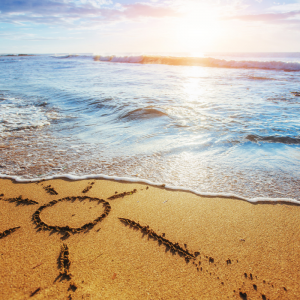 The best way to ensure your body has enough vitamin D is through sun exposure. Your body makes its own vitamin D when the cholesterol in your skin is exposed to sunlight (as long as your skin is not slathered in sunscreen). In fact, your body can produce 10,000 to 25,000 IU of vitamin D in less than the time it would take for your skin to begin to burn (provided you are exposing a large area of skin, like your back).
The best way to ensure your body has enough vitamin D is through sun exposure. Your body makes its own vitamin D when the cholesterol in your skin is exposed to sunlight (as long as your skin is not slathered in sunscreen). In fact, your body can produce 10,000 to 25,000 IU of vitamin D in less than the time it would take for your skin to begin to burn (provided you are exposing a large area of skin, like your back).
If you are concerned about sun exposure or live in a location where sunshine is not particularly plentiful (or during the winter, when the sun is too weak), it is a good idea to take a vitamin D supplement (the best form is vitamin D3).
Foods high in vitamin D include fatty fish (such as salmon and tuna), egg yolks and cheese. Only animal products are sources of vitamin D unless a plant product has been fortified. That said, it is difficult to get sufficient vitamin D from the diet alone. Click here to read my post on Vitamin D for the Dark Days of Winter.
Vitamin K
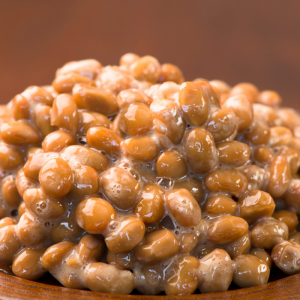 Vitamin K is also vitally important. It has a role in the formation of osteocalcin, which is an essential protein in bone-matrix that binds calcium in bone. Vitamin K is really a collection of vitamins. The two most commonly found in food are vitamin K1 and vitamin K2. Good dietary sources of vitamin K1 include many of those same vegetables high in calcium, such as kale, collards, broccoli and Brussels sprouts. Vitamin K2 is found in fermented foods and animal products. Natto is a powerhouse source of vitamin K2. It is a traditional Japanese food made from fermented soybeans (pictured at left) and definitely an acquired taste. Our gut bacteria also produces vitamin K2, which is yet another reason to tend to the care and feeding of your garden of gut flora.
Vitamin K is also vitally important. It has a role in the formation of osteocalcin, which is an essential protein in bone-matrix that binds calcium in bone. Vitamin K is really a collection of vitamins. The two most commonly found in food are vitamin K1 and vitamin K2. Good dietary sources of vitamin K1 include many of those same vegetables high in calcium, such as kale, collards, broccoli and Brussels sprouts. Vitamin K2 is found in fermented foods and animal products. Natto is a powerhouse source of vitamin K2. It is a traditional Japanese food made from fermented soybeans (pictured at left) and definitely an acquired taste. Our gut bacteria also produces vitamin K2, which is yet another reason to tend to the care and feeding of your garden of gut flora.
Other nutrients needed for healthy bones
Many other nutrients (more than 20) are needed for bone health as well, either as constituents of bone or required for enzymatic activity or regulation of bone formation. This could be why better bone health correlates with higher intakes of vegetables and fruits.
Bone is a mixture of minerals (primarily calcium, phosphorous, magnesium, sodium and potassium) deposited around a protein matrix that acts as a sort of scaffold. This gives bones the required combination of both strength and flexibility.
The best sources of phosphorous are fish, shellfish, nuts and seeds. Seafood, nuts and seeds are excellent source of magnesium as well. Dark, leafy greens and cruciferous vegetables are chock full of both magnesium and potassium.
Collagen makes up 90% to 95% of the protein matrix of bone
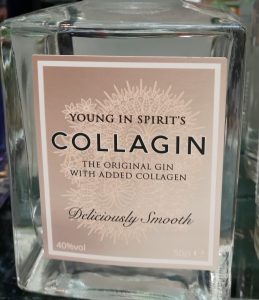 As for the protein matrix, collagen is the major protein in bone. It makes up 90% to 95% of the matrix. Incorporating bone broth, seafood and organ meats in your diet are all great ways to boost your collagen intake. And collagen is widely available as a supplement (it tends to be odourless and tasteless and dissolves easily so a good one to add to smoothies, soups or yogurt etc.). Note that gin with collagen added (pictured at left) doesn’t count. Remember “don’t drink”… 😉
As for the protein matrix, collagen is the major protein in bone. It makes up 90% to 95% of the matrix. Incorporating bone broth, seafood and organ meats in your diet are all great ways to boost your collagen intake. And collagen is widely available as a supplement (it tends to be odourless and tasteless and dissolves easily so a good one to add to smoothies, soups or yogurt etc.). Note that gin with collagen added (pictured at left) doesn’t count. Remember “don’t drink”… 😉
Break these habits (and not your bones)…
We’ve boned up on the foods and nutrients that promote bone health. Now let’s consider those that are less savoury.
Don’t drink, don’t smoke…
 High alcohol intake reduces calcium absorption and interferes with the liver’s metabolism of vitamin D. Limit alcohol to no more than 2 to 3 drinks per day.
High alcohol intake reduces calcium absorption and interferes with the liver’s metabolism of vitamin D. Limit alcohol to no more than 2 to 3 drinks per day.
Studies have shown a direct relationship between tobacco use and decreased bone density but proving causation is more complicated. Is the decreased bone density due to smoking itself or to other risk factors common among people who smoke? For example, many people who smoke are thinner than nonsmokers, tend to drink more alcohol, may be less physically active and/or have less healthy diets. And women who smoke also tend to have an earlier menopause than nonsmokers. All of these are also risk factors for osteoporosis. There is evidence, however, showing smoking has a negative impact on bone healing after fracture.
Slash sugar
Another reason it is important to have a healthy diet of whole foods is that insulin has a role in bone mineralization as well. Insulin is important for driving the activity of the bone-building osteoblasts. If, through a diet of sugary foods and ultra-refined carbohydrates, we permit ourselves to become insulin resistant, we put ourselves at greater risk of fracture. In fact, skeletal deterioration is a common complication of diabetes.
Keep a lid on caffeine
Caffeine (e.g. coffee, tea, some soft drinks etc.) may contribute to bone loss by decreasing calcium absorption. So it is a good idea to keep a lid on your caffeine intake (as in, no more than 3 cups of coffee a day). And it goes without saying that sugary caffeinated drinks are definitely not on the menu.
Try not to stress out
Earlier I mentioned that stressing your bones is good for them. By that I meant a measured amount of physical stress, one that prompts your bones to adapt in healthy ways. Too much stress, or chronic stress anywhere in the body, on the other hand, increases your risk of osteoporosis. This is because cortisol, our body’s primary stress hormone, actually leaches calcium from the bones. And this is why the risk of osteoporosis rises in those that use corticosteroids, man-made drugs that closely resemble cortisol (e.g. cortisone, hydrocortisone and prednisone).
This stress may be physical, as in the physical stress of ridding the body of the toxic compounds in cigarette smoke or alcohol, for example. It can also be mental stress, such as anxiety over issues with work, finances, family or other personal relationships. Vacations can be a source of stress, with the rigours of airplane travel, jet lag and other changes in routine. [And remember my earlier mention of those sections of the Wales Coast Path that were just steps away from sheer cliff drops? That was pretty stressful!] Even things that might seem relatively innocuous, like not getting enough sleep or eating too quickly, are also a stress on the body. So be mindful of how much stress you are experiencing. Then take steps to reduce it and bring more relaxation into your life.
The bare bones to prevent osteoporosis
- eat a healthy diet of whole foods including lots of vegetables and fruits (aim to fill 75% of your plate with them),
- be sure to incorporate enough calcium-rich foods in your diet on a daily basis (eat slowly and chew thoroughly to maximize digestion)
- break bone-weakening habits (smoking, excess alcohol, sugar and caffeine),
- reduce stress (easier said than done, I know, and a topic for another blog post) and
- get enough sleep.
- And don’t be a lazy bones! The healthiest thing you can do for your bones is USE THEM. Start strength training. Twice per week. Right now. Choose two days that work best for you and add strength training to your calendar as an appointment, for just 20 to 30 minutes. Be sure to set a reminder. I urge you to write down a plan for achieving this (don’t forget to include due dates for each step) and then show your plan to a friend or family member and ask them to hold you accountable. Strength training is fun. Before you know it, you’ll be having an osteo-blast!